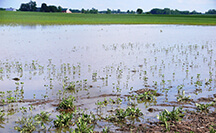Crop losses possible from flooding, Purdue experts say
June 17, 2015
 |
|
A soybean field in Hendricks County, Indiana, is partly covered by ponding water Tuesday (June 16) from frequent rain over several days in the central part of the state. More rain was expected throughout the week. (Purdue Agricultural Communication photo/Darrin Pack) |
WEST LAFAYETTE, Ind. – While assessing potential crop damage from recent torrential rains and flooding in parts of the Midwest will take time, farmers should be prepared for possible losses, Purdue Extension experts say.
"No one can tell you with certainty the day after the storm whether a ponded area of a corn field will survive or whether there will be long-term yield consequences until enough time has gone by such that you can evaluate the actual recovery of the damaged plants," said corn specialist Bob Nielsen. "But there are a lot of acres suffering excessive moisture, and it is deteriorating by the day."
Some northern Indiana counties have received twice their normal rainfall for the entire month in just the past few days. In Fort Wayne, the National Weather Service recorded 6.65 inches of rain for the first two weeks of June. The average rainfall in the city for the entire month is 4.2 inches.
 |
|
Indiana farmers should expect little relief from the weather this week. The forecast for the Tippecanoe County area that includes this flooded cornfield north of West Lafayette calls for more rain through the weekend. (Purdue Agricultural Communication photo/Tom Campbell) |
The downpour has caused flooding in some low-lying farm fields and left standing water in poorly drained areas, hindering development of newly planted corn and soybean crops.
"Everything is shallow-rooted," Nielsen said. "If the spigot is turned off tomorrow, we would rapidly move into drought stress."
Nielsen said young corn can likely survive up to about four days in standing water if temperatures are relatively cool. The risk increases the longer the plant is under water.
"Plants that are only partially submerged may continue to photosynthesize, albeit at limited rates," he said.
Nielsen has published an article describing all the factors that influence a corn plant’s ability to survive in a flooded or ponded field. The article, "Effects of Flooding or Ponding on Corn Prior to Tasseling," is available in the latest issue of Purdue's Pest and Crop online newsletter at http://extension.entm.purdue.edu/pestcrop/2015/Issue11/.
Poor field conditions have also made it difficult for some farmers to adequately fertilize their crops, leaving young plants starved of vital nutrients, said Jim Camberato, soil fertility specialist.
"Excessive rainfall and flooding can result in the loss of some spring-applied nitrogen," he said. "It leaches through the soil into tile drains or groundwater."
But he also said corn has “a tremendous capacity to respond to nitrogen, even if it is applied late in the season when the corn is shoulder high.”
Additional information resources for flood-damaged field crops are available on Nielsen's blog, the Chat 'n Chew Café, at http://www.agry.purdue.edu/ext/corn/cafe/.
Soybeans, which are typically planted later than corn, could be especially vulnerable to flooding since plants are less developed at this time.
"In the areas I have seen there has been a lot of standing water," said soybean specialist Shaun Casteel. "There is going to be nitrogen stress on plants that are under water."
While it is too late in the season to replant damaged corn crops, soybean growers could still decide to start over without losing any federal crop insurance coverage, but only if they act quickly, said Michael Langemeier, an agricultural economist specializing in crop systems.
The final date for planting soybeans with full insurance coverage is June 20. After that there is a 25-day late planting period where coverage drops 1 percent per day. Langemeier said farmers can't just write off flood-damaged fields.
"For insurance purposes, you need to make a good-faith effort to save the crop," Langemeier said.
Writer: Darrin Pack, 765-494-8415, dpack@purdue.edu
Sources: Bob Nielsen, 765-494-4802, rnielsen@purdue.edu
Jim Camberato, 765-496-9338, jcambera@purdue.edu
Shaun Casteel, 765-494-0895, scasteel@purdue.edu
Michael Langemeier, 765-494-9557, mlangeme@purdue.edu
Ag Communications: (765) 494-2722;
Keith Robinson, robins89@purdue.edu
Agriculture News Page

